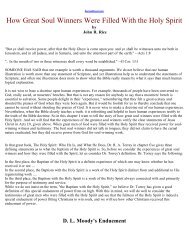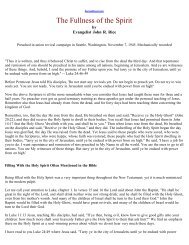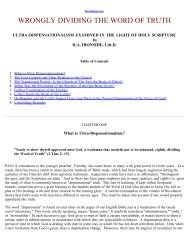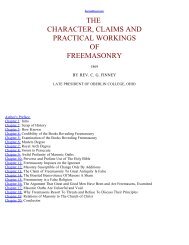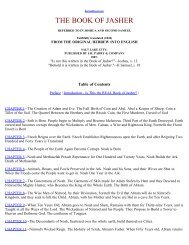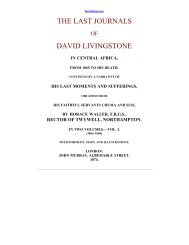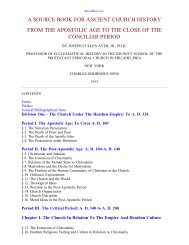Legends of Babylon and Egypt in Relation to Hebrew Tradition.pdf
Legends of Babylon and Egypt in Relation to Hebrew Tradition.pdf
Legends of Babylon and Egypt in Relation to Hebrew Tradition.pdf
Create successful ePaper yourself
Turn your PDF publications into a flip-book with our unique Google optimized e-Paper software.
example, which preceded that <strong>of</strong> Nîs<strong>in</strong>, becomes, if we like, the Third Dynasty <strong>of</strong> Ur. Another important fact which<br />
strikes us after a scrut<strong>in</strong>y <strong>of</strong> the early royal names recovered is that, while two or three are Semitic,[2] the great<br />
majority <strong>of</strong> those borne by the earliest rulers <strong>of</strong> Kish, Erech, <strong>and</strong> Ur are as obviously Sumerian.<br />
[1] See Poebel, /His<strong>to</strong>rical Texts/, pp. 73 ff. <strong>and</strong> /His<strong>to</strong>rical <strong>and</strong> Grammatical Texts/, pl. ii-iv, Nos. 2-5. The best<br />
preserved <strong>of</strong> the lists is No. 2; Nos. 3 <strong>and</strong> 4 are comparatively small fragments; <strong>and</strong> <strong>of</strong> No. 5 the obverse only is here<br />
published for the first time, the contents <strong>of</strong> the reverse hav<strong>in</strong>g been made known some years ago by Hilprecht (cf.<br />
/Mathematical, Metrological, <strong>and</strong> Chronological Tablets/, p. 46 f., pl. 30, No. 47). The fragments belong <strong>to</strong> separate<br />
copies <strong>of</strong> the Sumerian dynastic record, <strong>and</strong> it happens that the extant portions <strong>of</strong> their text <strong>in</strong> some places cover the<br />
same period <strong>and</strong> are duplicates <strong>of</strong> one another.<br />
[2] Cf., e.g., two <strong>of</strong> the earliest k<strong>in</strong>gs <strong>of</strong> Kish, Galumum <strong>and</strong> Zugagib. The former is probably the Semitic-<strong>Babylon</strong>ian<br />
word /kalumum/, "young animal, lamb," the latter /zukakîbum/, "scorpion"; cf. Poebel, /Hist. Texts/, p. 111. The<br />
occurrence <strong>of</strong> these names po<strong>in</strong>ts <strong>to</strong> Semitic <strong>in</strong>filtration <strong>in</strong><strong>to</strong> Northern <strong>Babylon</strong>ia s<strong>in</strong>ce the dawn <strong>of</strong> his<strong>to</strong>ry, a state <strong>of</strong><br />
th<strong>in</strong>gs we should naturally expect. It is improbable that on this po<strong>in</strong>t Sumerian tradition should have merely reflected<br />
the conditions <strong>of</strong> a later period.<br />
It is clear that <strong>in</strong> native tradition, current among the Sumerians themselves before the close <strong>of</strong> the third millennium,<br />
their race was regarded as <strong>in</strong> possession <strong>of</strong> <strong>Babylon</strong>ia s<strong>in</strong>ce the dawn <strong>of</strong> his<strong>to</strong>ry. This at any rate proves that their<br />
advent was not sudden nor comparatively recent, <strong>and</strong> it further suggests that <strong>Babylon</strong>ia itself was the cradle <strong>of</strong> their<br />
civilization. It will be the prov<strong>in</strong>ce <strong>of</strong> future archaeological research <strong>to</strong> fill out the miss<strong>in</strong>g dynasties <strong>and</strong> <strong>to</strong> determ<strong>in</strong>e<br />
at what po<strong>in</strong>ts <strong>in</strong> the list their strictly his<strong>to</strong>rical basis disappears. Some, which are fortunately preserved near the<br />
beg<strong>in</strong>n<strong>in</strong>g, bear on their face their legendary character. But for our purpose they are none the worse for that.<br />
In the first two dynasties, which had their seats at the cities <strong>of</strong> Kish <strong>and</strong> Erech, we see gods m<strong>in</strong>gl<strong>in</strong>g with men upon<br />
the earth. Tammuz, the god <strong>of</strong> vegetation, for whose annual death Ezekiel saw women weep<strong>in</strong>g beside the Temple at<br />
Jerusalem, is here an earthly monarch. He appears <strong>to</strong> be described as "a hunter", a phrase which recalls the death <strong>of</strong><br />
Adonis <strong>in</strong> Greek mythology. Accord<strong>in</strong>g <strong>to</strong> our Sumerian text he reigned <strong>in</strong> Erech for a hundred years.<br />
Another attractive <strong>Babylon</strong>ian legend is that <strong>of</strong> Etana, the pro<strong>to</strong>type <strong>of</strong> Icarus <strong>and</strong> hero <strong>of</strong> the earliest dream <strong>of</strong> human<br />
flight.[1] Cl<strong>in</strong>g<strong>in</strong>g <strong>to</strong> the p<strong>in</strong>ions <strong>of</strong> his friend the Eagle he beheld the world <strong>and</strong> its encircl<strong>in</strong>g stream recede beneath<br />
him; <strong>and</strong> he flew through the gate <strong>of</strong> heaven, only <strong>to</strong> fall headlong back <strong>to</strong> earth. He is here duly entered <strong>in</strong> the list,<br />
where we read that "Etana, the shepherd who ascended <strong>to</strong> heaven, who subdued all l<strong>and</strong>s", ruled <strong>in</strong> the city <strong>of</strong> Kish for<br />
635 years.<br />
[1] The <strong>Egypt</strong>ian conception <strong>of</strong> the deceased Pharaoh ascend<strong>in</strong>g <strong>to</strong> heaven as a falcon <strong>and</strong> becom<strong>in</strong>g merged <strong>in</strong><strong>to</strong> the<br />
sun, which first occurs <strong>in</strong> the Pyramid texts (see Gard<strong>in</strong>er <strong>in</strong> Cumont's /Études Syriennes/, pp. 109 ff.), belongs <strong>to</strong> a<br />
different range <strong>of</strong> ideas. But it may well have been comb<strong>in</strong>ed with the Etana tradition <strong>to</strong> produce the funerary eagle<br />
employed so commonly <strong>in</strong> Roman Syria <strong>in</strong> representations <strong>of</strong> the emperor's apotheosis (cf. Cumont, op. cit., pp. 37 ff.,<br />
115).<br />
The god Lugal-b<strong>and</strong>a is another hero <strong>of</strong> legend. When the hearts <strong>of</strong> the other gods failed them, he alone recovered the<br />
Tablets <strong>of</strong> Fate, s<strong>to</strong>len by the bird-god Zû from Enlil's palace. He is here recorded <strong>to</strong> have reigned <strong>in</strong> Erech for 1,200<br />
years.<br />
<strong>Tradition</strong> already <strong>to</strong>ld us that Erech was the native city <strong>of</strong> Gilgamesh, the hero <strong>of</strong> the national epic, <strong>to</strong> whom his<br />
ances<strong>to</strong>r Ut-napishtim related the s<strong>to</strong>ry <strong>of</strong> the Flood. Gilgamesh <strong>to</strong>o is <strong>in</strong> our list, as k<strong>in</strong>g <strong>of</strong> Erech for 126 years.<br />
We have here <strong>in</strong> fact recovered traditions <strong>of</strong> Post-diluvian k<strong>in</strong>gs. Unfortunately our list goes no farther back than that,<br />
but it is probable that <strong>in</strong> its orig<strong>in</strong>al form it presented a general correspondence <strong>to</strong> the system preserved from Berossus,<br />
which enumerates ten Antediluvian k<strong>in</strong>gs, the last <strong>of</strong> them Xisuthros, the hero <strong>of</strong> the Deluge. Indeed, for the dynastic<br />
period, the agreement <strong>of</strong> these old Sumerian lists with the chronological system <strong>of</strong> Berossus is strik<strong>in</strong>g. The latter,<br />
accord<strong>in</strong>g <strong>to</strong> Syncellus, gives 34,090 or 34,080 years as the <strong>to</strong>tal duration <strong>of</strong> the his<strong>to</strong>rical period, apart from his<br />
preced<strong>in</strong>g mythical ages, while the figure as preserved by Eusebius is 33,091 years.[1] The compiler <strong>of</strong> one <strong>of</strong> our new<br />
lists,[2] writ<strong>in</strong>g some 1,900 years earlier, reckons that the dynastic period <strong>in</strong> his day had lasted for 32,243 years. Of



